Also known as “Our Nation’s River,” the Potomac River has a rich history, intertwined with the foundation of the United States. George Washington, the first president of the U.S., grew up along the river and built his home at Mount Vernon along its banks. The U.S. capital of Washington D.C. lies along the river’s eastern bank, and the river itself provides drinking water for millions of people.
Nearly 60% of the Potomac River’s watershed is covered in forest, making it one of the most forested regions in the country. Many animals live along its banks, including a wide variety of mammals, reptiles, amphibians, and birds. Additionally, more than 100 species of fish and numerous crustaceans and mollusks call its waters home. This richness in plant and animal life makes the Potomac River one of the most biodiverse waterways in the country. That said, what sort of creatures can you find lurking at the bottom of the Potomac River?
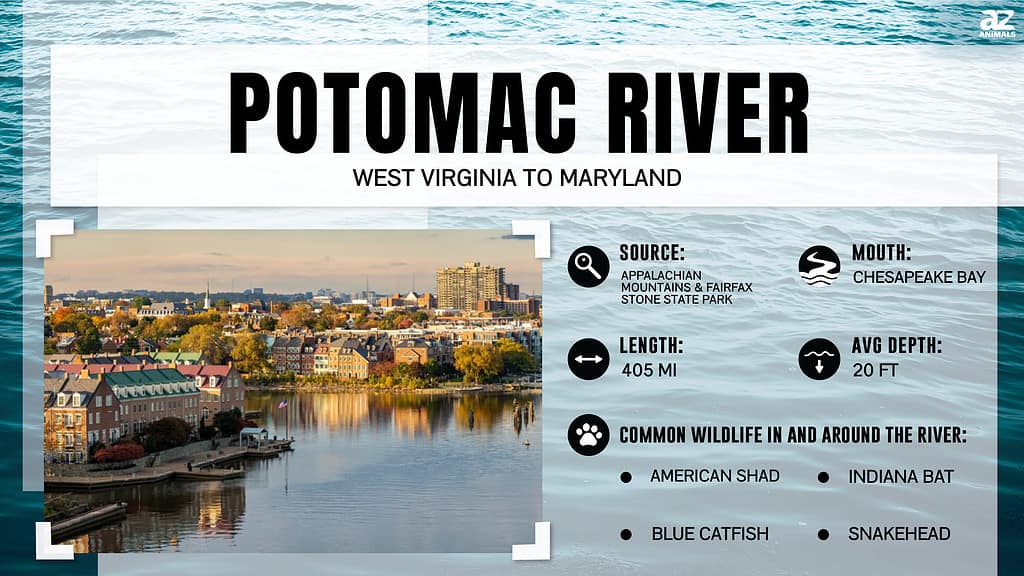
Keep reading to discover five animals that live on the bottom of the Potomac River. Along the way, you’ll also learn more about the river itself and whether it is dangerous.
About the Potomac River

The Potomac travels through several geographic regions, including the Appalachian Plateau and the Piedmont Plateau.
©iStock.com/SeanPavonePhoto
The Potomac River begins at the confluence of two branches, the North Branch and the South Branch, near Green Spring in Hampshire County, West Virginia. Its North Branch originates at Fairfax Stone Historical Monument State Park in Preston County, West Virginia. Meanwhile, the South Branch rises near Hightown in Highland County, Virginia. From the confluence of these two branches, the river flows roughly southeast toward the Chesapeake Bay. Parts of the river act as the border between both Maryland and Washington D.C. and Virginia and West Virginia. Along its course, it travels through several distinct geographic regions, including the Appalachian Plateau, the Piedmont Plateau, and the Atlantic coastal plain.
The Potomac River is 405 miles long when measured from the source of the North Branch to its mouth at the Chesapeake Bay. At that length, the Potomac River ranks as the 21st longest river in the United States and the 4th longest on the east coast. Over five million people live inside the river’s 14,700 square mile drainage basin. Several rivers feed into the Potomac River along its course, including Antietam Creek, Monocacy River, Shenandoah River, Goose Creek, and Wicomico River.
People first arrived in the Potomac River region around 14,000 years ago. The word “Potomac” derives from Patawomeck, the European spelling for the name of an Algonquian village that used to exist on the river’s southern bank. Captain John Smith explored the river in 1608 and created the first map of the region in 1612. The early European colonists relied on the river for navigation and used it as a trading route. During the Civil War, the river acted as part of the boundary between the Union and the Confederacy and witnessed several major naval battles between the two powers.
Is the Potomac River Dangerous?
The Potomac River features some of the best whitewater rafting and boating in the world. Many people visit the Potomac River each year to boat on its rapids or swim in its waters. However, authorities caution people from taking undue risks when on the Potomac River. Several parts of the river feature strong currents and sharp rocks that make it unsafe for swimming. Almost every year, someone goes swimming in the river or falls into the water and doesn’t return. Additionally, inexperienced boaters should not attempt to go on the river without the proper equipment or an experienced guide.
For years, the Potomac River was one of the most polluted rivers in the region. Pollution from mining operations, agricultural runoff, and sewage decreased the river’s water quality greatly. It got so bad that green algae blooms covered the river’s entire surface due to chemical and bacterial levels in the water. Thankfully, the river has gotten much cleaner in recent years. However, some parts of the river are still considered unsafe for swimming.
What Lives at the Bottom of the Potomac River?
A wide variety of plants and animals live in and around the Potomac River. You can find over 60 mammals along its banks, including bats, deer, bears, rodents, and foxes. Additionally, the river supports hundreds of birds and dozens of reptiles and amphibians, including frogs, snakes, lizards, salamanders, and turtles. Meanwhile, within the Potomac River, you can find more than 100 species of freshwater fish, as well as several tidal freshwater fish. But which animals reside at the bottom of this great river?
American Eel
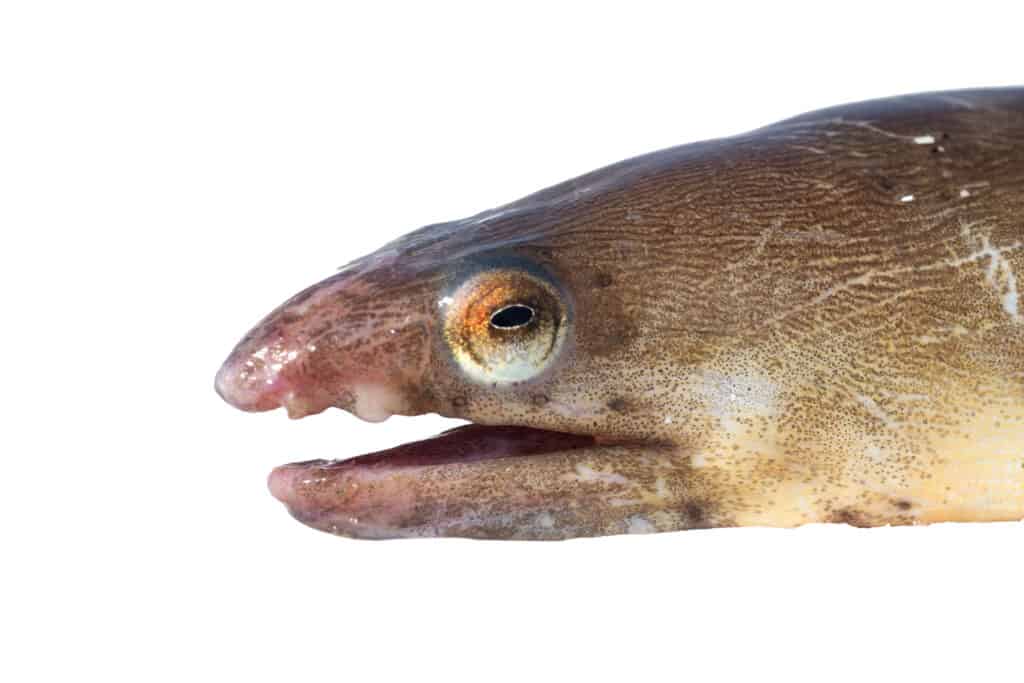
American eels are bottom dwellers that live in burrows, under ledges, and within thick vegetation.
©IrinaK/Shutterstock.com
The American eel (Anguilla rostrata) is a member of the freshwater eel family Anguillidae. These slimy, snake-like fish live in freshwater habitats in the eastern half of North America. They can grow up to 4 feet long and weigh up to 17 pounds. In terms of color, American eels primarily appear olive green or brown, except on their bellies, which look whitish yellow. American eels are bottom dwellers that live in burrows, under ledges, and within thick vegetation. They are nocturnal carnivores that rely on their keen sense of smell to find food. Their diet consists mostly of crustaceans, insects, and other small aquatic lifeforms. Commercial fisheries used to harvest American eels in large numbers. However, American eel populations have significantly declined in recent decades due to habitat loss. Presently, the IUCN lists the American eel as an endangered species.
American Shad
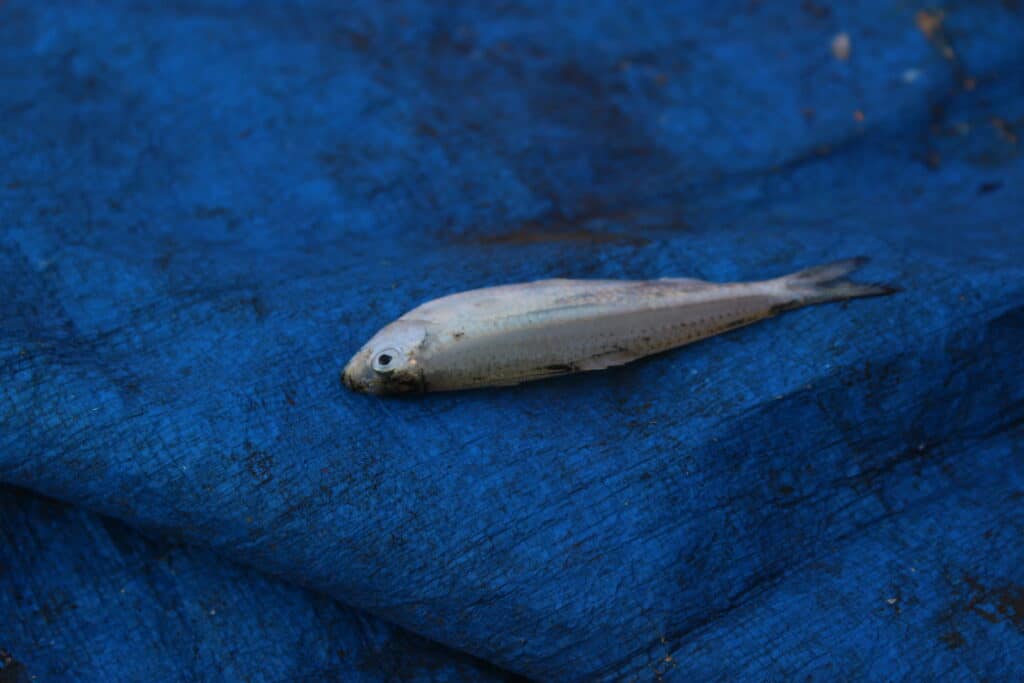
American shads feature silver scales on each side and blue-green scales along their backs.
©Radhe Modi/Shutterstock.com
The American shad (Alosa sapidissima) is a member of the family Clupeidae, which also includes herrings and sardines. A native to the coasts of eastern North America, you can now find American shads along the Pacific coast of North America as well. On average, American shads measure between three and eight pounds. They feature silver scales on each side and blue-green scales along their backs. Like herrings, American shads primarily feed on plankton but also prey on small shrimp and fish eggs. American shad are anadromous, meaning they spawn in freshwater and migrate out to sea to grow and mature.
American colonists harvested American shad in great quantities, so much so that it is sometimes called “the fish that fed America’s founders.” By the early 20th century, American shad populations plummeted due to the construction of dams that blocked their migration routes. In recent years, American shad populations have rebounded thanks to projects aimed at reducing migration barriers, such as the Chesapeake Bay Program. Today, the IUCN classifies the American shad as a species of Least Concern.
Common Bottlenose Dolphin

You can often see dolphins swimming in pods in the Potomac River.
©Faraj Meir / Creative Commons – Original
The common bottlenose dolphin is one of the most recognizable animals in the Potomac River. They are the largest species of beaked dolphin, with adults ranging from 6.6 to 13.1 feet long. They weigh between 330 and 1,430 pounds, with males typically measuring larger than females. They sport short snouts shaped like a bottle, hence their name. Their diet consists mainly of fish, eels, shrimp, and squids, which they swallow whole. You can often see dolphins swimming in pods. Like other dolphins, they communicate with one another and find prey using echolocation, a type of sonar. They display complex social relationships, and scientists recognize them as one of the most intelligent animals worldwide. Despite protests from activists, common bottlenose dolphins are often kept in marine parks or aquariums. With a global population of around 600,000, the IUCN lists the common bottlenose dolphin as a species of Least Concern.
Bowfin
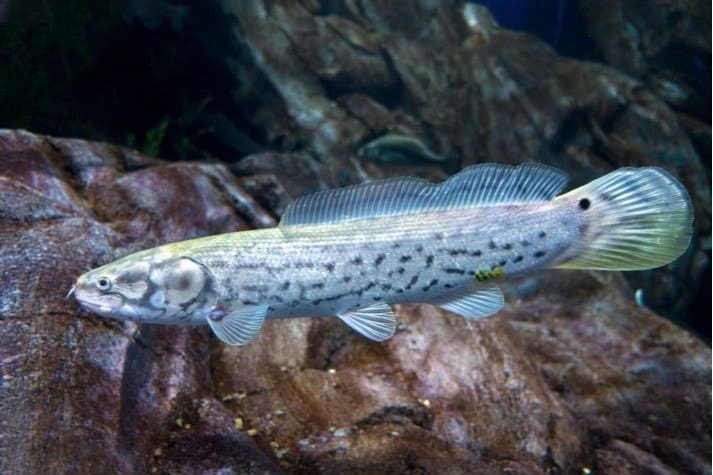
Bowfins’ bodies are olive-brown with dark bars that function as a form of camouflage.
©Miroslav Halama/Shutterstock.com
The bowfin (Amia calva) goes by many names, including mud pike, swamp trout, and dogfish. Bowfins first evolved nearly 250 million years ago, and the modern bowfin bears a close resemblance to its primitive ancestors. On average, bowfins measure between 20 and 43 inches long, and they can weigh up to 21.5 pounds. They possess cylindrical, olive-brown bodies marked with dark bars that function as a form of camouflage. The bowfin gets its name from its long dorsal fin, which runs almost the full length of the back to the tail and contains between 145 and 250 rays. You can typically find bowfins in swamps or vegetated rivers and lakes. They are bottom-dwelling carnivores that primarily prey on other fish as well as crayfish, insects, and mollusks. Although they have a reputation for putting up a fight, most anglers do not prize bowfins as game fish.
Bull Shark
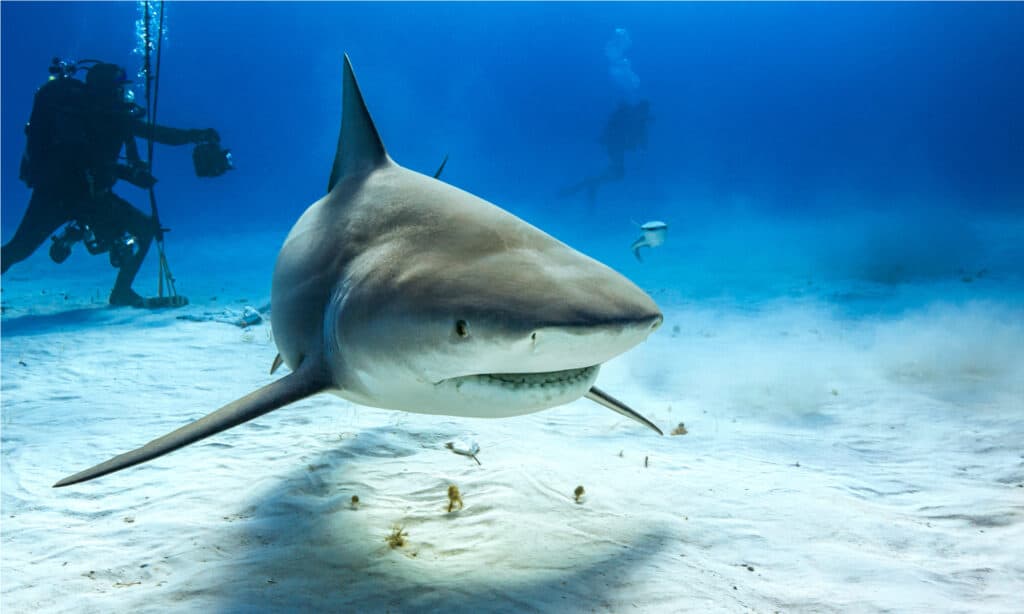
Bull sharks’ ability to travel up rivers means they often wind up in areas where people don’t expect them to reside.
©Carlos Grillo/Shutterstock.com
The bull shark (Carcharhinus leucas) is one of the most notorious shark species in the world. Bull sharks are euryhaline, meaning that they can live in both fresh water and salt water. Their ability to travel up rivers means they often wind up in areas where people don’t expect them to reside. As a result, bull sharks are responsible for a disproportionate number of shark attacks near shores. Bull sharks have large, wide bodies. They measure 7 to 11 feet long and between 290 and 990 pounds, with females measuring larger than males. Bull sharks mostly feed on fish, stingrays, and smaller sharks, including other bull sharks. Since they often live close to coastlines, bull sharks are very susceptible to habitat loss, pollution, and hunting. Presently, the IUCN classifies the bull shark as a Vulnerable species.
Interesting Facts
- The Potomac River ranks as the 21st largest river in the United States and the 4th largest river along the country’s east coast.
- The Potomac River measures nearly 405 miles long and drains an area of 14,700 square miles.
- “Potomac” is a European version of Patawomeck, the name of an Algonquian village that used to exist on the river’s southern bank.
- The Potomac River witnessed several major battles during the American Civil War, including the Battle of Ball’s Bluff and the Battle of Shepherdstown.
- Improving water quality and management of the Potomac River has seen an increase in the river’s biodiversity, including the re-emergence of bottlenose dolphins and American shad.
The photo featured at the top of this post is © iStock.com/Jon Bilous
Thank you for reading! Have some feedback for us? Contact the AZ Animals editorial team.







